独立主格with用法小全
- 格式:doc
- 大小:29.48 KB
- 文档页数:19
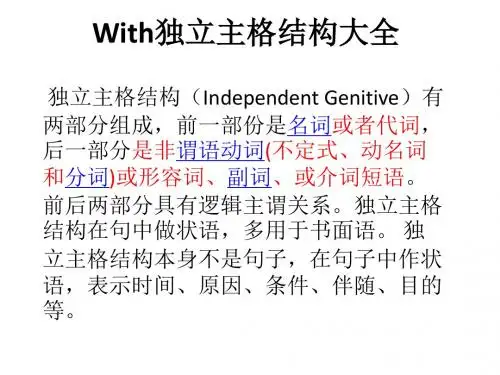
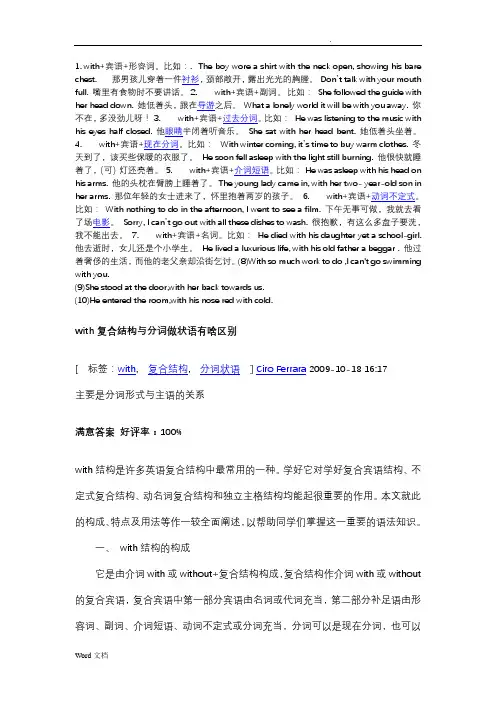
1.with+宾语+形容词。
比如:. The boy wore a shirt with the neck open, showing his bare chest. 那男孩儿穿着一件衬衫,颈部敞开,露出光光的胸膛。
Don’t talk with your mouth full. 嘴里有食物时不要讲话。
2.with+宾语+副词。
比如:She followed the guide with her head down. 她低着头,跟在导游之后。
What a lonely world it will be with you away. 你不在,多没劲儿呀!3.with+宾语+过去分词。
比如:He was listening to the music with his eyes half closed. 他眼睛半闭着听音乐。
She sat with her head bent. 她低着头坐着。
4.with+宾语+现在分词。
比如:With winter coming, it’s time to buy warm clothes. 冬天到了,该买些保暖的衣服了。
He soon fell asleep with the light still burning. 他很快就睡着了,(可)灯还亮着。
5.with+宾语+介词短语。
比如:He was asleep with his head on his arms. 他的头枕在臂膀上睡着了。
The young lady came in, with her two- year-old son in her arms. 那位年轻的女士进来了,怀里抱着两岁的孩子。
6.with+宾语+动词不定式。
比如:With nothing to do in the afternoon, I went to see a film. 下午无事可做,我就去看了场电影。
Sorry, I can’t go out with all these dishes to wash. 很抱歉,有这么多盘子要洗,我不能出去。
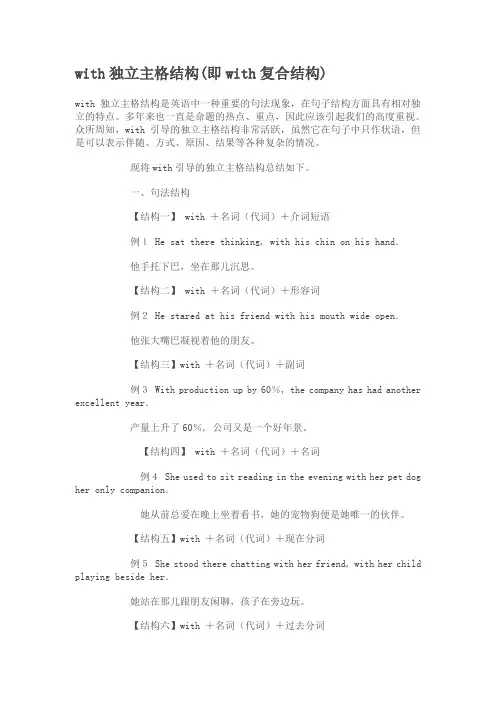
with独立主格结构(即with复合结构)with独立主格结构是英语中一种重要的句法现象,在句子结构方面具有相对独立的特点。
多年来也一直是命题的热点、重点,因此应该引起我们的高度重视。
众所周知,with引导的独立主格结构非常活跃,虽然它在句子中只作状语,但是可以表示伴随、方式、原因、结果等各种复杂的情况。
现将with引导的独立主格结构总结如下。
一、句法结构【结构一】 with +名词(代词)+介词短语例1 He sat there thinking, with his chin on his hand.他手托下巴,坐在那儿沉思。
【结构二】 with +名词(代词)+形容词例2 He stared at his friend with his mouth wide open.他张大嘴巴凝视着他的朋友。
【结构三】with +名词(代词)+副词例3 With production up by 60%, the company has had another excellent year.产量上升了60%, 公司又是一个好年景。
【结构四】 with +名词(代词)+名词例4 She used to sit reading in the evening with her pet dog her only companion.她从前总爱在晚上坐着看书,她的宠物狗便是她唯一的伙伴。
【结构五】with +名词(代词)+现在分词例5 She stood there chatting with her friend, with her child playing beside her.她站在那儿跟朋友闲聊,孩子在旁边玩。
【结构六】with +名词(代词)+过去分词例6“I think we can leave with our heads held high,” Eriksson said.“我认为我们可以高昂着头离开,”艾里克松说。
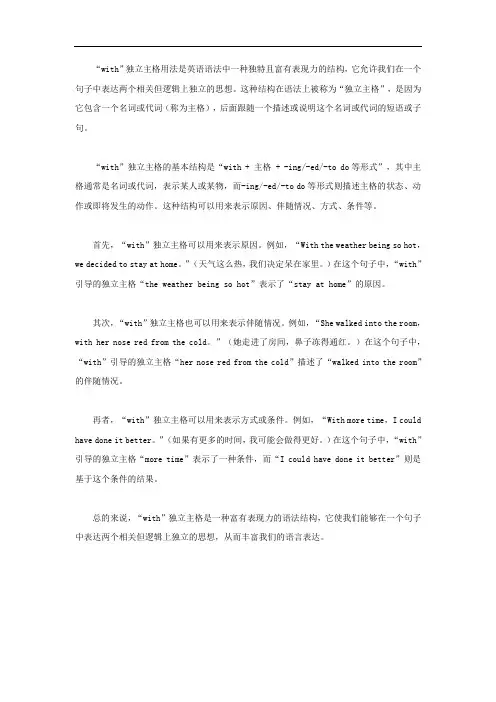
“with”独立主格用法是英语语法中一种独特且富有表现力的结构,它允许我们在一个句子中表达两个相关但逻辑上独立的思想。
这种结构在语法上被称为“独立主格”,是因为它包含一个名词或代词(称为主格),后面跟随一个描述或说明这个名词或代词的短语或子句。
“with”独立主格的基本结构是“with + 主格 + -ing/-ed/-to do等形式”,其中主格通常是名词或代词,表示某人或某物,而-ing/-ed/-to do等形式则描述主格的状态、动作或即将发生的动作。
这种结构可以用来表示原因、伴随情况、方式、条件等。
首先,“with”独立主格可以用来表示原因。
例如,“With the weather being so hot,we decided to stay at home。
”(天气这么热,我们决定呆在家里。
)在这个句子中,“with”引导的独立主格“the weather being so hot”表示了“stay at home”的原因。
其次,“with”独立主格也可以用来表示伴随情况。
例如,“She walked into the room,with her nose red from the cold。
”(她走进了房间,鼻子冻得通红。
)在这个句子中,“with”引导的独立主格“her nose red from the cold”描述了“walked into the room”的伴随情况。
再者,“with”独立主格可以用来表示方式或条件。
例如,“With more time,I could have done it better。
”(如果有更多的时间,我可能会做得更好。
)在这个句子中,“with”引导的独立主格“more time”表示了一种条件,而“I could have done it better”则是基于这个条件的结果。
总的来说,“with”独立主格是一种富有表现力的语法结构,它使我们能够在一个句子中表达两个相关但逻辑上独立的思想,从而丰富我们的语言表达。
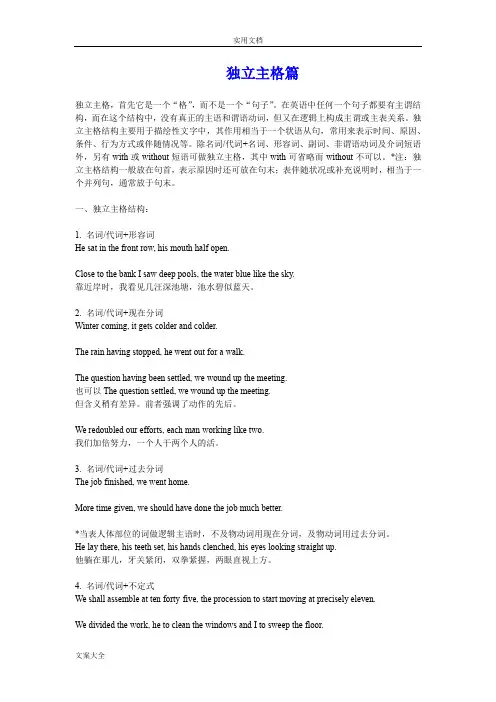
独立主格篇独立主格,首先它是一个“格”,而不是一个“句子”。
在英语中任何一个句子都要有主谓结构,而在这个结构中,没有真正的主语和谓语动词,但又在逻辑上构成主谓或主表关系。
独立主格结构主要用于描绘性文字中,其作用相当于一个状语从句,常用来表示时间、原因、条件、行为方式或伴随情况等。
除名词/代词+名词、形容词、副词、非谓语动词及介词短语外,另有with或without短语可做独立主格,其中with可省略而without不可以。
*注:独立主格结构一般放在句首,表示原因时还可放在句末;表伴随状况或补充说明时,相当于一个并列句,通常放于句末。
一、独立主格结构:1. 名词/代词+形容词He sat in the front row, his mouth half open.Close to the bank I saw deep pools, the water blue like the sky.靠近岸时,我看见几汪深池塘,池水碧似蓝天。
2. 名词/代词+现在分词Winter coming, it gets colder and colder.The rain having stopped, he went out for a walk.The question having been settled, we wound up the meeting.也可以The question settled, we wound up the meeting.但含义稍有差异。
前者强调了动作的先后。
We redoubled our efforts, each man working like two.我们加倍努力,一个人干两个人的活。
3. 名词/代词+过去分词The job finished, we went home.More time given, we should have done the job much better.*当表人体部位的词做逻辑主语时,不及物动词用现在分词,及物动词用过去分词。

with独立主格结构是英语中一种重要的句法现象,在句子结构方面具有相对独立的特点。
多年来也一直是命题的热点、重点,因此应该引起我们的高度重视。
众所周知,wi th引导的独立主格结构非常活跃,虽然它在句子中只作状语,但是可以表示伴随、方式、原因、结果等各种复杂的情况。
现将with引导的独立主格结构总结如下。
一、句法结构1. with +名词(代词)+介词短语He sat there thinking, with his chin on his hand.他手托下巴,坐在那儿沉思。
The old man stood there, with his back against thewall.那位老人背倚着墙站在那里。
Mary was sitting near the fire, with her back towards thedoor.玛丽*近火炉坐着,背对着门。
2. with +名词(代词)+形容词He stared at his friend with his mouth wide open.他张大嘴巴凝视着他的朋友。
The man raised his head with eyes full of wonder andmystery.这人抬起头来,眼里充满了好奇。
He stood there trembling, with his face red withcold.他站在那儿瑟瑟发抖,脸都冻红了。
3. with +名词(代词)+副词With production up by 60%, the company has had other excellentyear.产量上升了60%, 公司又是一个好年景。
The stupid Emperor walked in the procession with nothingon.这位愚蠢的皇帝一丝不挂地行进在游行队伍中。
The naughty boy stood before his teacher with hishead down.这个淘气的男孩低着头站在老师面前。
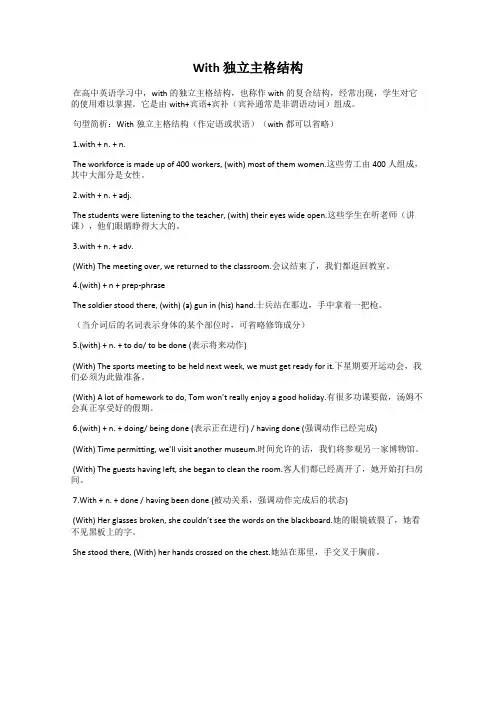
With 独立主格结构在高中英语学习中,with的独立主格结构,也称作with的复合结构,经常出现,学生对它的使用难以掌握。
它是由with+宾语+宾补(宾补通常是非谓语动词)组成。
句型简析:With独立主格结构(作定语或状语)(with都可以省略)1.with + n. + n.The workforce is made up of 400 workers, (with) most of them women.这些劳工由400人组成,其中大部分是女性。
2.with + n. + adj.The students were listening to the teacher, (with) their eyes wide open.这些学生在听老师(讲课),他们眼睛睁得大大的。
3.with + n. + adv.(With) The meeting over, we returned to the classroom.会议结束了,我们都返回教室。
4.(with) + n + prep-phraseThe soldier stood there, (with) (a) gun in (his) hand.士兵站在那边,手中拿着一把枪。
(当介词后的名词表示身体的某个部位时,可省略修饰成分)5.(with) + n. + to do/ to be done (表示将来动作)(With) The sports meeting to be held next week, we must get ready for it.下星期要开运动会,我们必须为此做准备。
(With) A lot of homework to do, Tom won’t really enjo y a good holiday.有很多功课要做,汤姆不会真正享受好的假期。
6.(with) + n. + doing/ being done (表示正在进行) / having done (强调动作已经完成)(With) Time permitting, we’ll visit another museum.时间允许的话,我们将参观另一家博物馆。
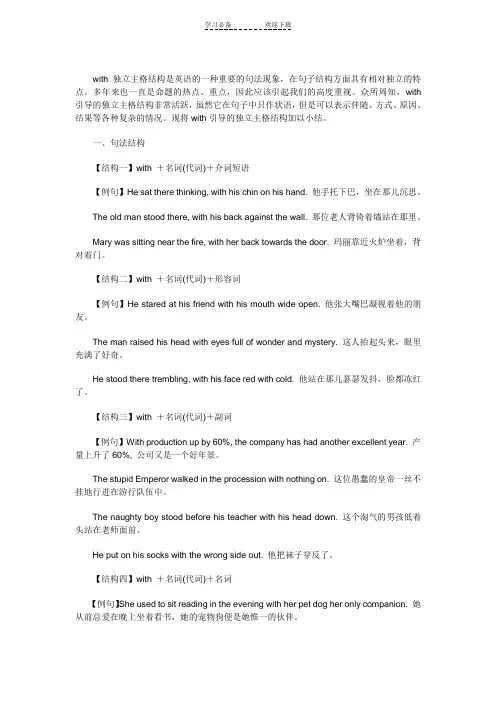
with独立主格结构是英语的一种重要的句法现象,在句子结构方面具有相对独立的特点。
多年来也一直是命题的热点、重点,因此应该引起我们的高度重视。
众所周知,with 引导的独立主格结构非常活跃,虽然它在句子中只作状语,但是可以表示伴随、方式、原因、结果等各种复杂的情况。
现将with引导的独立主格结构加以小结。
一、句法结构【结构一】with +名词(代词)+介词短语【例句】He sat there thinking, with his chin on his hand. 他手托下巴,坐在那儿沉思。
The old man stood there, with his back against the wall. 那位老人背倚着墙站在那里。
Mary was sitting near the fire, with her back towards the door. 玛丽靠近火炉坐着,背对着门。
【结构二】with +名词(代词)+形容词【例句】He stared at his friend with his mouth wide open. 他张大嘴巴凝视着他的朋友。
The man raised his head with eyes full of wonder and mystery. 这人抬起头来,眼里充满了好奇。
He stood there trembling, with his face red with cold. 他站在那儿瑟瑟发抖,脸都冻红了。
【结构三】with +名词(代词)+副词【例句】With production up by 60%, the company has had another excellent year. 产量上升了60%, 公司又是一个好年景。
The stupid Emperor walked in the procession with nothing on. 这位愚蠢的皇帝一丝不挂地行进在游行队伍中。
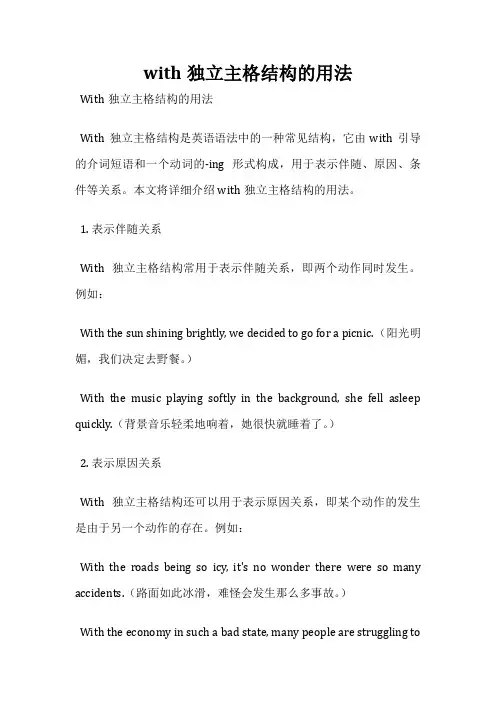
with独立主格结构的用法With独立主格结构的用法With独立主格结构是英语语法中的一种常见结构,它由with引导的介词短语和一个动词的-ing形式构成,用于表示伴随、原因、条件等关系。
本文将详细介绍with独立主格结构的用法。
1. 表示伴随关系With独立主格结构常用于表示伴随关系,即两个动作同时发生。
例如:With the sun shining brightly, we decided to go for a picnic.(阳光明媚,我们决定去野餐。
)With the music playing softly in the background, she fell asleep quickly.(背景音乐轻柔地响着,她很快就睡着了。
)2. 表示原因关系With独立主格结构还可以用于表示原因关系,即某个动作的发生是由于另一个动作的存在。
例如:With the roads being so icy, it's no wonder there were so many accidents.(路面如此冰滑,难怪会发生那么多事故。
)With the economy in such a bad state, many people are struggling tomake ends meet.(经济如此糟糕,许多人都在苦苦挣扎。
)3. 表示条件关系With独立主格结构还可以用于表示条件关系,即某个动作的发生是在某种条件下。
例如:With the weather being so unpredictable, we decided to bring both umbrellas and sunscreen.(天气如此不可预测,我们决定带上雨伞和防晒霜。
)With the deadline approaching, we worked late into the night to finish the project.(截止日期临近,我们熬夜工作以完成项目。
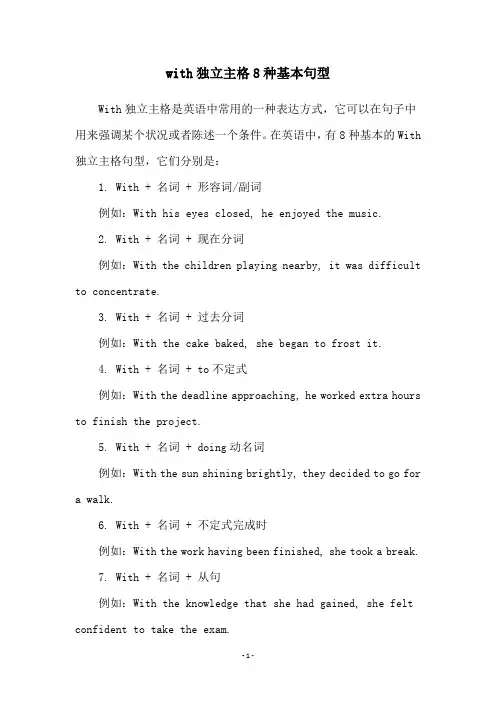
with独立主格8种基本句型With独立主格是英语中常用的一种表达方式,它可以在句子中用来强调某个状况或者陈述一个条件。
在英语中,有8种基本的With 独立主格句型,它们分别是:1. With + 名词 + 形容词/副词例如:With his eyes closed, he enjoyed the music.2. With + 名词 + 现在分词例如:With the children playing nearby, it was difficult to concentrate.3. With + 名词 + 过去分词例如:With the cake baked, she began to frost it.4. With + 名词 + to不定式例如:With the deadline approaching, he worked extra hours to finish the project.5. With + 名词 + doing动名词例如:With the sun shining brightly, they decided to go fora walk.6. With + 名词 + 不定式完成时例如:With the work having been finished, she took a break.7. With + 名词 + 从句例如:With the knowledge that she had gained, she felt confident to take the exam.8. With + 名词 + 介词短语例如:With his hand on her shoulder, he reassured her that everything would be alright.这8种With独立主格句型在英语中使用非常广泛,可以用来表达各种不同的情境和意思。
学会运用它们,能够让我们的英语表达更加地流畅自然。
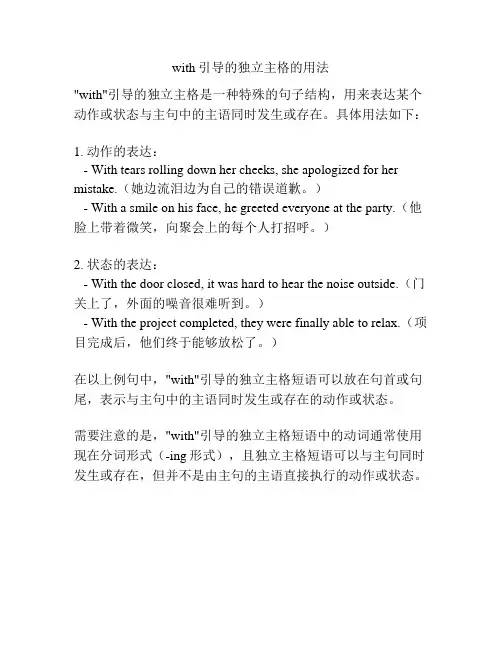
with引导的独立主格的用法
"with"引导的独立主格是一种特殊的句子结构,用来表达某个动作或状态与主句中的主语同时发生或存在。
具体用法如下:
1. 动作的表达:
- With tears rolling down her cheeks, she apologized for her mistake.(她边流泪边为自己的错误道歉。
)
- With a smile on his face, he greeted everyone at the party.(他脸上带着微笑,向聚会上的每个人打招呼。
)
2. 状态的表达:
- With the door closed, it was hard to hear the noise outside.(门关上了,外面的噪音很难听到。
)
- With the project completed, they were finally able to relax.(项目完成后,他们终于能够放松了。
)
在以上例句中,"with"引导的独立主格短语可以放在句首或句尾,表示与主句中的主语同时发生或存在的动作或状态。
需要注意的是,"with"引导的独立主格短语中的动词通常使用现在分词形式(-ing形式),且独立主格短语可以与主句同时发生或存在,但并不是由主句的主语直接执行的动作或状态。
with做独立主格的用法
在英语中,“with”可以作为独立主格的用法,通常用于表示伴随、时间、原因、条件等关系。
以下是“with”作为独立主格的用法示例:
1. 表示伴随:With a book in hand, he walked into the library. (他手里拿着一本书走进了图书馆。
)
2. 表示时间:With the sun shining brightly, we decided to have
a picnic. (在阳光明媚的时候,我们决定去野餐。
)
3. 表示原因:With all the work to do, he can't go out for dinner. (因为所有的工作都要做,他不能出去吃饭。
)
4. 表示条件:With enough time, we could have done the project better. (如果有足够的时间,我们能把项目做得更好。
)
5. 表示方式:With the help of the internet, people can learn new things easily. (在互联网的帮助下,人们可以很容易地学习新事物。
)
需要注意的是,“with”作为独立主格时,其后的名词或代词与主句的主语不是同一个,而是作为伴随、时间、原因、条件等的补充说明。
需要将“with”引导的短语中的动词省略,并在短语后加上逗号。
此外,如果独立主格的主语和主句主语不一致时,需要使用代词或名词代替原来的主语。
1。
中考英语《句型结构》知识点:With的复合结构作独立主格在句子中,With可以引导复合结构作为独立主格来描述动作进行的方式、原因、伴随状态等情况。
下面是一些常见的使用With复合结构作独立主格的句型结构:1. With + 名词短语:用于描述动作进行的方式或条件。
例如:- With a smile, he greeted everyone in the room. (带着微笑,他向房间里的每个人问好。
)- With a lot of practice, you will improve your English. (通过大量的练习,你会提高英语水平。
)2. With + 动词的ing形式:用于描述动作进行时的伴随状态或条件。
例如:- With the baby crying, it was hard to concentrate. (宝宝在哭,很难集中注意力。
)- With the team working together, they completed the project on time. (团队一起努力,他们按时完成了项目。
)3. With + 副词/介词短语/从句:用于描述动作进行的原因或条件。
例如:- With the weather being so hot, we decided to go swimming. (由于天气太热,我们决定去游泳。
)- With the price of gas rising, many people are using public transportation. (由于汽油价格上涨,很多人使用公共交通工具。
)需要注意的是,With的复合结构作独立主格时,常与主谓语动词形成非限制性定语从句的关系,可以省略关系代词或并列连词(如that, which, and)。
希望以上内容对你有所帮助!。
with独立主格结构就是英语的一种重要的句法现象,在句子结构方面具有相对独立的特点。
多年来也一直就是命题的热点、重点,因此应该引起我们的高度重视。
众所周知,with引导的独立主格结构非常活跃,虽然它在句子中只作状语,但就是可以表示伴随、方式、原因、结果等各种复杂的情况。
现将with引导的独立主格结构加以小结。
一、句法结构【结构一】with +名词(代词)+介词短语【例句】He sat there thinking, with his chin on his hand、她手托下巴,坐在那儿沉思。
The old man stood there, with his back against the wall、那位老人背倚着墙站在那里。
Mary was sitting near the fire, with her back towards the door、玛丽靠近火炉坐着,背对着门。
【结构二】with +名词(代词)+形容词【例句】He stared at his friend with his mouth wide open、她张大嘴巴凝视着她的朋友。
The man raised his head with eyes full of wonder and mystery、这人抬起头来,眼里充满了好奇。
He stood there trembling, with his face red with cold、她站在那儿瑟瑟发抖,脸都冻红了。
【结构三】with +名词(代词)+副词【例句】With production up by 60%, the company has had another excellent year、产量上升了60%, 公司又就是一个好年景。
The stupid Emperor walked in the procession with nothing on、这位愚蠢的皇帝一丝不挂地行进在游行队伍中。
独立主格w i t h用法小全The final revision was on November 23, 2020独立主格篇独立主格,首先它是一个“格”,而不是一个“句子”。
在英语中任何一个句子都要有主谓结构,而在这个结构中,没有真正的主语和谓语动词,但又在逻辑上构成主谓或主表关系。
独立主格结构主要用于描绘性文字中,其作用相当于一个状语从句,常用来表示时间、原因、条件、行为方式或伴随情况等。
除名词/代词+名词、形容词、副词、非谓语动词及介词短语外,另有with或without短语可做独立主格,其中with可省略而without不可以。
*注:独立主格结构一般放在句首,表示原因时还可放在句末;表伴随状况或补充说明时,相当于一个并列句,通常放于句末。
一、独立主格结构:1. 名词/代词+形容词He sat in the front row, his mouth half open.Close to the bank I saw deep pools, the water blue like the sky.靠近岸时,我看见几汪深池塘,池水碧似蓝天。
2. 名词/代词+现在分词Winter coming, it gets colder and colder.The rain having stopped, he went out for a walk.The question having been settled, we wound up the meeting.也可以The question settled, we wound up the meeting.但含义稍有差异。
前者强调了动作的先后。
We redoubled our efforts, each man working like two.我们加倍努力,一个人干两个人的活。
3. 名词/代词+过去分词The job finished, we went home.More time given, we should have done the job much better.*当表人体部位的词做逻辑主语时,不及物动词用现在分词,及物动词用过去分词。
初中英语With的基本用法与独立主格with结构是许多英语复合结构中最常用的一种。
学好它对学好复合宾语结构、不定式复合结构、动名词复合结构和独立主格结构均能起很重要的作用。
一、 with结构的构成它是由介词with或without+复合结构构成,复合结构作介词with或without的复合宾语,复合宾语中第一部分宾语由名词或代词充当,第二部分补足语由形容词、副词、介词短语、动词不定式或分词充当,分词可以是现在分词,也可以是过去分词。
With结构构成方式如下:1. with或without-名词/代词+形容词;2. with或without-名词/代词+副词;3. with或without-名词/代词+介词短语;4. with或without-名词/代词 +动词不定式;5. with或without-名词/代词 +分词。
下面分别举例:1、She came into the room,with her nose red because of cold.(with+名词+形容词,作伴随状语)2、With the meal over, we all went home.(with+名词+副词,作时间状语)3、The master was walking up and down with the ruler under his arm。
(with+名词+介词短语,作伴随状语。
)4、He could not finish it without me to help him.(without+代词 +不定式,作条件状语)5、She fell asleep with the light on.(with+名词+现在分词,作伴随状语)二、with结构的用法with是介词,其意义颇多,一时难掌握。
为帮助大家理清头绪,以教材中的句子为例,进行分类,并配以简单的解释。
在句子中with结构多数充当状语,表示行为方式,伴随情况、时间、原因或条件(详见上述例句)。
【With的基本用法与独立主格】with结构是许多英语复合结构中最常用的一种。
学好它对学好复合宾语结构、不定式复合结构、动名词复合结构和独立主格结构均能起很重要的作用。
一、with结构的构成它是由介词with或without+复合结构构成,复合结构作介词with或without的复合宾语,复合宾语中第一部分宾语由名词或代词充当,第二部分补足语由形容词、副词、介词短语、动词不定式或分词充当,分词可以是现在分词,也可以是过去分词。
With结构构成方式如下:1. with或without-名词/代词+形容词;2. with或without-名词/代词+副词;3. with或without-名词/代词+介词短语;4. with或without-名词/代词+动词不定式;5. with或without-名词/代词+分词。
下面分别举例:1、She came into the room,with her nose red because of cold.(with+名词+形容词,作伴随状语)2、With the meal over, we all went home.(with+名词+副词,作时间状语)3、The master was walking up and down with the ruler under his arm。
(with+名词+介词短语,作伴随状语。
)4、He could not finish it without me to help him.(without+代词+不定式,作条件状语)5、She fell asleep with the light on.(with+名词+现在分词,作伴随状语)二、with结构的用法with是介词,其意义颇多,一时难掌握。
为帮助大家理清头绪,以教材中的句子为例,进行分类,并配以简单的解释。
在句子中with结构多数充当状语,表示行为方式,伴随情况、时间、原因或条件(详见上述例句)。
独立主格篇独立主格,首先它是一个“格”,而不是一个“句子”。
在英语中任何一个句子都要有主谓结构,而在这个结构中,没有真正的主语和谓语动词,但又在逻辑上构成主谓或主表关系。
独立主格结构主要用于描绘性文字中,其作用相当于一个状语从句,常用来表示时间、原因、条件、行为方式或伴随情况等。
除名词/代词+名词、形容词、副词、非谓语动词及介词短语外,另有with或without短语可做独立主格,其中with可省略而without不可以。
*注:独立主格结构一般放在句首,表示原因时还可放在句末;表伴随状况或补充说明时,相当于一个并列句,通常放于句末。
一、独立主格结构:1. 名词/代词+形容词He sat in the front row, his mouth half open.Close to the bank I saw deep pools, the water blue like the sky.靠近岸时,我看见几汪深池塘,池水碧似蓝天。
2. 名词/代词+现在分词Winter coming, it gets colder and colder.The rain having stopped, he went out for a walk.The question having been settled, we wound up the meeting.也可以The question settled, we wound up the meeting.但含义稍有差异。
前者强调了动作的先后。
We redoubled our efforts, each man working like two.我们加倍努力,一个人干两个人的活。
3. 名词/代词+过去分词The job finished, we went home.More time given, we should have done the job much better.*当表人体部位的词做逻辑主语时,不及物动词用现在分词,及物动词用过去分词。
He lay there, his teeth set, his hands clenched, his eyes looking straight up.他躺在那儿,牙关紧闭,双拳紧握,两眼直视上方。
4. 名词/代词+不定式We shall assemble at ten forty-five, the procession to start moving at precisely eleven.We divided the work, he to clean the windows and I to sweep the floor.Here are the first two volumes, the third one to come out next month.5. 名词/代词+介词短语I followed him here, and climbed in, sword in hand.The huntsman entered the forest, gun in hand.He sat at the table, coat off, head down, and pen in hand.coat off名词+副词;head down名词+副词;pen in hand名词+介词短语。
This Contract shall be signed in duplicate, one for each Party.本合同一式两份,双方各执一份。
*名词/代词+介词短语中介词为in时,其前后的两个名词一般不加任何成分(如物主代词或冠词)。
A robber burst into the room, knife in hand.A girl came in, book in hand.如若有修饰词,必须对称出现,例句:A girl came in, a book in her hand.故以下二句为错误用法:A girl came in, book in her hand.A girl came in, a book in hand.而with短语则可随意加限定词。
A girl came in, with some books in both hands.A girl came in, with a book in her hand.6名词/代词+副词Nobody in, the thief took a lot of things away.Lunch over, he left the house. But he was thinking.7 名词/代词+名词He fought the wolf, a stick his only weapon.他和狼搏斗着,唯一的武器是一根棍棒。
8 with+名词+分词(或形容词、副词、不定式等)He was asleep with his head on his arms.With John away, we have got more room.He stood at the door, with a computer in his hand.或He stood at the door, computer in hand.* with或without短语作定语,独立主格结构功能相当于一个定语从句,通常with前无逗号。
He is the person with a lot of questions to be settled.他就是有许多问题要解决的那个人。
He was walking along the road without any street lights on its both sides.他走在一条两边没有路灯的马路上。
二、独立主格的变化过程:When the coffin had been interred, the minister said a few comforting words.The coffin (having been) interred, the minister said a few comforting words.棺材入土后,牧师说了几句安慰的话。
三、独立主格注意事项:1. 独立主格结构没有所有格形式:The chief-editor's arriving, we began the meeting. (×)The chief-editor arriving, we began the meeting.(√)2. 其他独立主格结构,其中以下结构不能省略being (having been):2.1 There being +名词(代词)There being nothing else to do, we went home.没有别的事可做,我们就回家了。
There being no further business, I declare the meeting closed. 没有再要讨论的事了,我宣布散会。
There being no bus, we had to go home on foot.因为没有公共汽车,所以我们不得不步行回家。
2.2 逻辑主语为人称代词,being不可省:It being Christmas, the government offices were closed.由于圣诞节的缘故,政府机关都休息。
It being a holiday, all the shops were shut.由于今天是假日,所有商店都关门了。
It being Sunday, we went to church.因为是星期天,我们去了做礼拜。
2.3 当独立主格结构中being done 表示“正在被做时”,being不可省略。
This article deals with common social problems, with much attention being paid to problems of teenagers.Food being cooked, I fell asleep.3. 独立主格中的代词要用主格形式,但也有例外:Everyone laughed, me included. (《张道真英语语法》商务印书馆)。
me included为宾格+过去分词。
Since the early years of the twentieth century, when the International Athletic Federation began keeping record, there has been a steady improvement in how fast athletes run, how high they jump and how far they are able to hurl massive objects, themselves included, through space.themselves included为反身代词+过去分词。
四、具有独立主格功能的其他结构:1. 当独立主格结构的主语表示“一般人”,如:we, one, you时,主语可省略,此用法常用于下列表达方式中:generally speaking 一般来说strictly speaking 严格地说talking of ... 谈到speaking of ... 说到judging from ... 由……来判断taking all things into consideration 把一切都考虑在内considering ... 考虑到……[示例]If we judge from his face, he must be ill.= Judging from his face, he must be ill.He has lots of books if we consider that he is young. = He has lots of books, considering that he is young.Generally speaking, the rule is very easy to understand. 总的说来,这条规则很容易懂。
Judging from what he said, he must be an honest man. 由他所说的来判断,他一定是一个诚实的人。
2. 有些固定短语是带to 的不定式,表明说话人的立场或态度,在句中作独立成分。